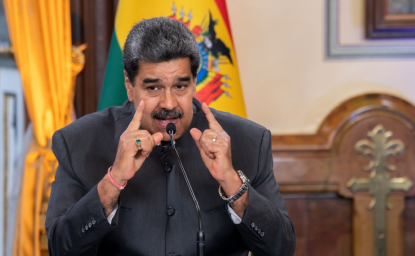The collapse in trade, investment, and jobs due to the coronavirus has been widespread, hitting all regions and many industries. As economies shut down, demand plunged, labor markets weakened, and the cross-border flows of goods, services, people, and investment collapsed. Even before the pandemic, however, global trade growth was decelerating. Foreign investment was also contracting on account of a global slowdown in economic activity, escalating trade tensions, rising protectionism, and recent U.S. tax changes that incentivized American firms to repatriate foreign profits.
After bottoming out in May and June 2020, transatlantic trade in goods quickly rebounded and is now close to pre-pandemic levels. Services trade, an increasingly important avenue for global commerce and for transatlantic commercial ties in particular, will take much longer to recover, and will depend on progress in vaccine distribution and the lifting of travel restrictions.
The economic damage from COVID-19 extends far beyond trade. Foreign affiliate sales, not trade, are the primary means by which U.S. and European firms deliver goods and services to foreign consumers. Multinational sales and investments, which have become essential to U.S. and European jobs and prosperity, witnessed a sharp decline in 2020 due to collapsing profits, heightened business uncertainty and an overall weakening of global demand. According to the United Nations, global FDI flows were down 42% in 2020, with severe declines in Europe and North America driving the downturn.

Yet even with the hit from the coronavirus and much talk of de-globalization, the United States and Europe remain deeply intertwined and embedded in each other’s markets. Consumers and producers, workers and companies, citizens, and their governments on both sides of the Atlantic directly benefit from the deep integrative forces that bind the United States and Europe together.
Indeed, despite the 2020 slowdown, the transatlantic economy remains the fulcrum of the global economy. The combined output of the United States and the EU27 plus close partners Switzerland, the UK, Iceland, and Norway accounted for roughly one-third of world GDP in terms of purchasing power parity in 2020 – higher than the combined output of the newly formed Regional Comprehensive Economic Partnership (RCEP) in Asia (30% of world GDP).
The transatlantic economy is not only larger than China and India in terms of GDP, it is significantly wealthier. Consumers in the United States and the EU easily outspend their counterparts in China and India. As mentioned in Chapter One, together the United States and the EU (including the UK) accounted for 50% of global personal consumption in 2019, versus a combined share of just 15% for China and India. Per capita incomes – a key metric of a nation’s wealth – are far higher in the United States ($65,300), the EU27 ($35,000) and the UK ($42,300) than either China ($10,300) or India ($2,100).
In addition, the transatlantic economy is a repository of innovation and technological advancement, and at the forefront of global foreign direct investment (FDI) and global mergers and acquisitions (M&A) activity. Taken together, U.S. and European exports to the world (excluding intra-EU trade) accounted for 27% of global exports in 2019, the last year of complete data; combined imports represented 32% of the world total. Meanwhile, the United States and Europe together accounted for 61% of inward FDI stock and 64% of outward FDI stock. Each partner has built up the great majority of that stock in the other economy.

It is no surprise, therefore, that the largest commercial relationship in the world stretches across the Atlantic. Total transatlantic foreign affiliate sales were estimated at $6.2 trillion in 2019, easily ranking as the top commercial artery in the world on account of the thick investment ties between the two parties.
That said, the burgeoning middle class of the developing nations represents a new source of supply (labor) and demand (consumers) for U.S. and European firms. American and European firms are building out their presence in the developing nations, and for good reason. Economic growth rates are still above the global average in most of these nations, populated with young consumers who desire Western goods and services. In addition, the technological skill levels of many developing nations are now on par with many developed nations. China, for instance, is rapidly emerging as an innovation superpower. India lags behind but is advancing. More people in Latin America, Africa and the Middle East are online and connecting to the digital economy.
What is often missing from this either-or picture, however, is the fact that many U.S. and European firms use each other’s markets as a launchpad to other parts of the world. Many European car companies, for instance, invest in the United States and then export cars made in the U.S.A. to China and other countries. U.S. services companies, in turn, use the scale offered by their dense investment linkages with Europe to be globally competitive when it comes to offering services in other parts of the world. Many U.S. multinationals also use their presence in stable and secure Europe to supply both goods and services to the burgeoning, but often volatile, markets of North Africa and the Middle East.
Authors



Global Europe Program
The Global Europe Program is focused on Europe’s capabilities, and how it engages on critical global issues. We investigate European approaches to critical global issues. We examine Europe’s relations with Russia and Eurasia, China and the Indo-Pacific, the Middle East and Africa. Our initiatives include “Ukraine in Europe”—an examination of what it will take to make Ukraine’s European future a reality. But we also examine the role of NATO, the European Union and the OSCE, Europe’s energy security, transatlantic trade disputes, and challenges to democracy. The Global Europe Program’s staff, scholars-in-residence, and Global Fellows participate in seminars, policy study groups, and international conferences to provide analytical recommendations to policy makers and the media. Read more

Explore More
Browse Insights & Analysis
360° View of How Southeast Asia Can Attract More FDI in Chips and AI


